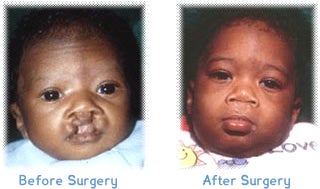Cleft Lip & Palate
 A cleft lip and palate occur when a baby is born with an opening in the roof of the mouth (palate) and the upper lip does not fully form.
A cleft lip and palate occur when a baby is born with an opening in the roof of the mouth (palate) and the upper lip does not fully form.
These conditions can occur separately so that some children are born with a cleft lip but a normal palate, and some have a cleft palate but a normal upper lip.
A completely formed lip is important not only for a normal facial appearance but also for sucking and to form certain sounds made during speech.
What is the Palate?
The palate is the roof of your mouth. You can feel your own palate by running your tongue over the top of your mouth. If you open your mouth and look into a mirror you will see that the palate extends from your teeth all the way back to the little dangling extension, called the uvula, in the middle of the back of your mouth.
Some facts about the palate:
- it’s made of bone and muscle and covered by a thin, wet skin that forms the red covering inside the mouth
- it separates your nose from your mouth much like a floor separates the basement from the ground floor
- it’s important for speech: preventing air from blowing out of your nose instead of your mouth when you talk
- it’s important for eating: preventing food and liquids from going up into the nose
- during swallowing, the tongue presses up against the palate and pushes the chewed food to the back of the throat where it then goes down into the stomach
What is a Cleft Palate?
 A cleft is a gap or split between two objects. A cleft palate is one that has not formed properly during the baby’s growth inside of the mother. There is a split in the palate leaving a hole between the nose and the mouth.
A cleft is a gap or split between two objects. A cleft palate is one that has not formed properly during the baby’s growth inside of the mother. There is a split in the palate leaving a hole between the nose and the mouth.
If the split is not fixed, the child may develop problems with eating, swallowing, talking, and sometimes with hearing. Examples of such problems include food or liquids coming out from the nose while eating, repeated sinus and ear infections, and poor speech with a nasal sounding voice that is very hard to understand. If the cleft involves the bone of the upper jaw, the child’s teeth may also be affected which can alter the child’s ability to chew.
How Common is This Condition?
Cleft lip and palate is one of the most common birth defects, occurring in one of every 500-1000 babies.
Fortunately, there are specialized medical teams who perform surgery and provide the therapy needed to correct these conditions.
Children who are born with cleft lip and palate
are able to live normal and healthy lives.
Doctors and scientists do know how cleft palates form, but they still do not have a complete explanation for why they occur, or what causes them.
A combination of the child’s inherited traits and the environment within the mother’s womb during pregnancy is thought to be the most likely cause of clefting in an infant. In some way, the growth and development of the face are disrupted, resulting in a cleft.
